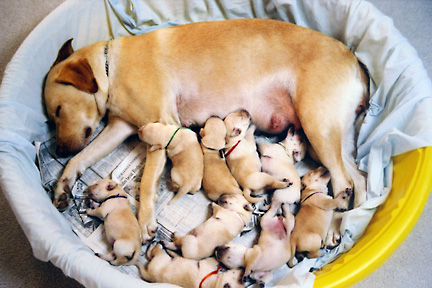
Baby animals are cute, but overpopulation starts with just one. This Labrador retriever, Winnie, had these puppies in May 2004. Winnie's owners report that all nine pups were adopted to friends and that Winnie has been spayed.
City’s Neuter Now
helps pet owners
Each year, thousands of puppies and kittens are born in Hawaii, more animals than there are homes. Many of these animals will end up homeless or abandoned.
In response, local pet organizations, veterinarians and humane societies join thousands of animal lovers across the state to educate pet owners as to why spay and neuter programs are so important.
Sizing up the problemOne un-neutered cat and her offspring can produce 420,000 kittens in seven years. And a single unaltered dog and her offspring can result in 67,000 puppies in six years.According to a 2004 Ward Research Study, more than 15 percent of Oahu households are feeding cats that they do not claim as their own. The Hawaiian Humane Society provides free sterilization service to feral cats. Visit Other Programs and Services at www.hawaiianhumane.org to learn more, or call 946-2187, ext. 285.
|
One easy way to help alleviate pet overpopulation is by getting your own animal spayed or neutered, or helping other pet owners get their animals spayed or neutered.
Oahu residents have an opportunity to take advantage of the city's Neuter Now program. Certificates for low-cost sterilization are available at all satellite city halls, the Hawaiian Humane Society and at www.hawaiianhumane.org.
The cost of the service is $40 for a male cat, $50 for a female cat or male dog, and $75 for a female dog. The one-time fee covers the pre-surgery exam, anesthesia and surgery. Some veterinarian clinics have other charges, so shop around for the best deal.
EBT card holders get a discount, paying $20 per cat or dog sterilization.
If you purchase a Neuter Now Certificate and call now to book your pet's sterilization surgery, your pet gets a free gift of a one-month supply of the flea preventive TopSpot or a microchip.
HERE ARE SOME common myths and misconceptions about sterilization:
Myth: I don't want my male dog or cat to feel like less of a male.
Fact: Pets don't have any concept of sexual identity or ego. Neutering will not change a pet's basic personality.
Myth: It's better to have one litter first.
Fact: Medical evidence indicates the opposite, showing that females spayed before their first heat typically are healthier. Many veterinarians now sterilize dogs and cats as young as 8 weeks of age.
Myth: My children should experience the miracle of birth.
Fact: Even if children are able to see a pet give birth -- which is unlikely because it usually occurs at night and in seclusion -- the lesson they will really learn is that animals can be created and discarded to suit human needs. Instead, children should be taught that life is the real miracle and preventing the birth of some pets can save the lives of others.
Myth: I want my dog to be protective.
Fact: Spaying or neutering does not affect a dog's instinct to protect home and family. A dog's personality is formed more by genetics and environment than by sex hormones.
Myth: My dog (or cat) is so special, I want a puppy (or kitten) just like her.
Fact: A dog or cat might be a great pet, but that doesn't mean her offspring will be a copy. Professional animal breeders who follow generations of bloodlines can't guarantee they will get what they want out of a particular litter. A pet owner's chances are even slimmer. In fact, a litter of puppies or kittens might receive all a pet's (and her mate's) worst characteristics.
Myth: It's too expensive to have a pet spayed or neutered.
Fact: The cost of spaying or neutering depends on the sex, size and age of the pet, your veterinarian's fees and a number of other variables. But whatever the price, spay or neuter surgery is a one-time cost that is a bargain compared with the cost of having a litter and ensuring the health of the mother and litter. Two months of pregnancy and another two months until the litter is weaned can add up to significant veterinary bills and food costs if complications develop.
Myth: I'll find good homes for all the puppies and kittens.
Fact: You might, but each home you find means one less home for the dogs and cats in shelters who also need good homes. Also, in less than one year's time, each of your pet's offspring could have its own litter, adding even more animals to the population. The problem of pet overpopulation is created and perpetuated one litter at a time.
[News] [Business] [Features] [Sports] [Editorial] [Do It Electric!]
[Classified Ads] [Search] [Subscribe] [Info] [Letter to Editor]
[Feedback]
